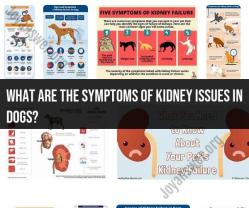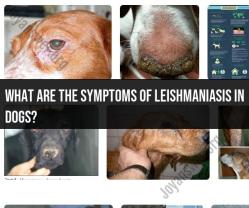What are the symptoms of mange in dogs and treatment?
Mange is a skin condition in dogs that is caused by various species of mites. There are two primary types of mange in dogs: Demodectic mange and Sarcoptic mange. Each type has distinct symptoms and treatments.
Demodectic Mange (Demodicosis):
Demodectic mange is typically caused by Demodex canis mites. These mites are naturally present on the skin of most dogs, but problems occur when there is an overpopulation or when the dog's immune system is weakened. Symptoms of demodectic mange include:
Hair Loss: Demodectic mange often starts with localized patches of hair loss, usually on the face, around the eyes, or on the forelimbs.
Redness and Scaly Skin: Affected areas may appear red, inflamed, or have a scaly appearance.
Itching: Some dogs may experience mild to moderate itching, but severe itching is less common.
Secondary Infections: Scratching and skin damage can lead to bacterial infections in severe cases.
Treatment for Demodectic Mange:Treatment for demodectic mange depends on the severity of the condition. Options may include:
- Topical Medications: Your veterinarian may prescribe medicated shampoos, dips, or creams to apply to the affected areas.
- Oral Medications: In more severe cases, oral medications such as ivermectin or milbemycin oxime may be prescribed.
- Antibiotics: If secondary bacterial infections are present, antibiotics may be necessary.
- Immune Support: Boosting the dog's immune system through a balanced diet and supplements may help control the mite population.
Sarcoptic Mange (Scabies):
Sarcoptic mange is caused by Sarcoptes scabiei mites. These mites are highly contagious and can be transmitted to other dogs and even humans. Symptoms of sarcoptic mange include:
Intense Itching: Dogs with sarcoptic mange experience severe itching, which often leads to frantic scratching, biting, and self-inflicted skin damage.
Hair Loss: Hair loss is common, and the skin may become red, crusty, and irritated.
Ear Involvement: Sarcoptic mange can affect the ears, leading to ear inflammation, discharge, and itching.
Secondary Infections: Bacterial infections may develop due to the dog's constant scratching and open sores.
Treatment for Sarcoptic Mange:Sarcoptic mange requires prompt treatment to alleviate the intense itching and discomfort. Treatment options typically include:
- Prescription Medications: Your veterinarian may prescribe oral or topical medications such as selamectin or moxidectin.
- Antibiotics: If secondary bacterial infections are present, antibiotics may be needed.
- Environmental Cleaning: Mites can survive in the environment, so thorough cleaning of the dog's living space is crucial to prevent reinfestation.
It's essential to consult with a veterinarian if you suspect your dog has mange. Mange can be challenging to diagnose accurately, and the type of mange and its severity will determine the appropriate treatment plan. Early intervention and proper treatment can help your dog recover from mange and alleviate their discomfort. Additionally, it's important to follow your veterinarian's recommendations for follow-up care and preventive measures to avoid future infestations.
Identifying Mange Symptoms in Dogs: Early Detection and Treatment
Mange is a skin condition caused by mites. There are three types of mange in dogs: sarcoptic mange, demodectic mange, and otodectic mange.
Sarcoptic mange is the most contagious type of mange and is caused by the Sarcoptes scabiei mite. This mite burrows into the skin, causing intense itching, hair loss, and crusting.
Demodectic mange is caused by the Demodex canis mite, which is a normal inhabitant of the skin. However, in some dogs, the mite population can grow out of control, causing hair loss and inflammation.
Otodectic mange, also known as ear mites, is caused by the Otodectes cynotis mite. This mite infects the ears, causing itching, redness, and a dark discharge.
Early Detection and Treatment
Early detection and treatment of mange is important to prevent the condition from worsening and spreading to other pets or people. Here are some tips for identifying mange symptoms in dogs:
- Hair loss: Mange can cause hair loss in patches or all over the body.
- Itching: Mange can cause intense itching, which can lead to scratching and self-mutilation.
- Redness and inflammation: Mange can cause the skin to become red and inflamed.
- Crusting and scabbing: Mange can cause the skin to crust over and scab.
- Dark discharge from the ears: Otodectic mange can cause a dark discharge from the ears.
If you notice any of these symptoms in your dog, it is important to see a veterinarian right away. Mange is a treatable condition, but early detection and treatment is key.
Treatment Options
The treatment for mange depends on the type of mange and the severity of the infection. Sarcoptic mange and otodectic mange are typically treated with topical medications or oral medications. Demodectic mange is often treated with medicated baths, topical medications, or oral medications.
In addition to medication, it is important to keep your dog's environment clean and free of mites. This may involve washing your dog's bedding and toys regularly and vacuuming your home frequently.
Managing Symptoms
In addition to medication, there are a number of things that you can do at home to help manage your dog's mange symptoms. These include:
- Bathing your dog regularly: Bathing your dog with a medicated shampoo can help to kill mites and relieve itching.
- Applying topical medications: Topical medications, such as ointments and creams, can be applied to the skin to kill mites and relieve inflammation.
- Giving your dog oral medications: Oral medications, such as antibiotics and anti-inflammatory drugs, may be prescribed to treat infections and inflammation associated with mange.
- Protecting your dog's skin: It is important to protect your dog's skin from further damage. This may involve using an Elizabethan collar to prevent scratching or applying a topical ointment to soothe the skin.
By working with your veterinarian and following their recommendations, you can help your dog to recover from mange and live a healthy and happy life.





